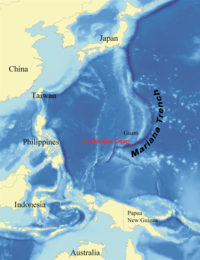
Photo from wikipedia
Matched field processing (MFP) is an established technique for source localization in multi-path acoustic environments that relies on correlating array-recorded and simulated sound fields. However, when the recorded sound field’s… Click to show full abstract
Matched field processing (MFP) is an established technique for source localization in multi-path acoustic environments that relies on correlating array-recorded and simulated sound fields. However, when the recorded sound field’s frequency is high enough, this field may be sensitive to details of the acoustic environment that are uncertain or unknown, and therefore not included in the simulated sound field. Thus, the actual and modeled acoustic fields are mismatched, the severity of this mismatch increases with frequency, and may cause MFP to fail at relevant frequencies and ranges in the deep ocean. One remedy to this problem may be analyzing the frequency-difference autoproduct of the acoustic field instead of analyzing the field itself. Thus, this presentation covers the simulated performance, and likely limitations, of frequency difference MFP [Worthmann and Dowling (2015). J. Acoust. Soc. Am. 138, 3549-3562] in a generic deep-ocean channel using a ray code (Bellhop) for the source-broadcast field in the signal bandwidth and a mode code (Kraken) for the replica calculations in the difference-frequency bandwidth. Here, refractive index fluctuations in the ocean are modeled by random time delays for each ray-path between the source and each receiver. [Sponsored by ONR.]Matched field processing (MFP) is an established technique for source localization in multi-path acoustic environments that relies on correlating array-recorded and simulated sound fields. However, when the recorded sound field’s frequency is high enough, this field may be sensitive to details of the acoustic environment that are uncertain or unknown, and therefore not included in the simulated sound field. Thus, the actual and modeled acoustic fields are mismatched, the severity of this mismatch increases with frequency, and may cause MFP to fail at relevant frequencies and ranges in the deep ocean. One remedy to this problem may be analyzing the frequency-difference autoproduct of the acoustic field instead of analyzing the field itself. Thus, this presentation covers the simulated performance, and likely limitations, of frequency difference MFP [Worthmann and Dowling (2015). J. Acoust. Soc. Am. 138, 3549-3562] in a generic deep-ocean channel using a ray code (Bellhop) for the source-broadcast field in ...
Journal Title: Journal of the Acoustical Society of America
Year Published: 2017
Link to full text (if available)
Share on Social Media: Sign Up to like & get
recommendations!